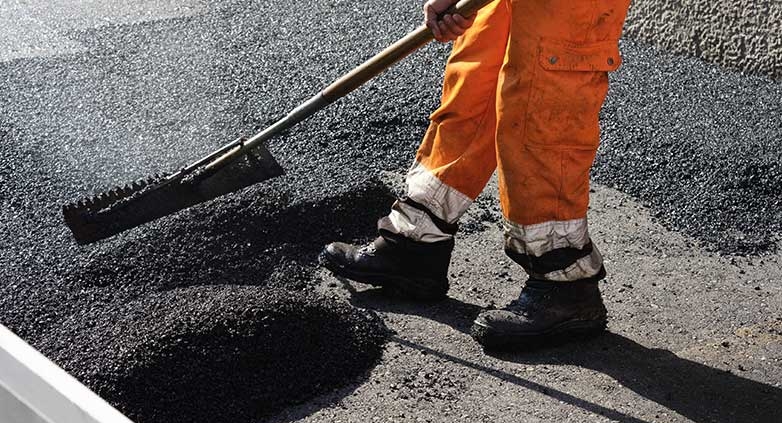Porous Asphalt – An Eco-Friendly Pavement Option
Understanding porous asphalt reveals its crucial role in mitigating stormwater runoff in urban areas, while maintaining the functional integrity of paved surfaces like parking lots and roads.
Porous asphalt, a unique mixture of aggregates and bituminous binder, creates a permeable surface, similar in appearance to traditional asphalt but with a rougher texture. This structure allows water to pass through to a granular base and stone reservoir beneath, effectively reducing runoff and promoting groundwater recharge. It’s an innovative approach to manage stormwater without requiring additional land for detention basins.
Explore the installation, maintenance, and environmental advantages of porous asphalt, particularly its effectiveness in urban stormwater management and contribution to sustainable infrastructure.
Uses for Porous Asphalt
This material has many uses, including parking lots, driveways, sidewalks, bike paths, and recreational areas like playgrounds, basketball courts, and tennis courts.
Urban and Residential Settings
Porous asphalt serves multiple purposes in both urban and residential areas. It’s widely used for constructing parking lots, driveways, and walkways. In urban settings, its application extends to bike paths and recreational areas, including playgrounds, basketball, and tennis courts. This versatility showcases its adaptability to various environmental and functional requirements.
Roadways and Streets

This type of asphalt isn’t limited to small-scale applications; it has also successfully implemented in residential and urban street constructions. Its ability to manage water runoff effectively makes it a preferred choice for such environments, where traditional pavement might lead to water accumulation and related issues.
Highway Applications
In highway construction, engineers use porous asphalt innovatively. Instead of applying it as a thin surface layer over conventional highway pavement, they typically use the typical layered approach with a stone bed. This design allows rainwater to seep through the porous layer and settle on an impermeable layer beneath, effectively managing water runoff and reducing the risk of water pooling on the highway surface.
Enhanced Safety During Rainstorms
One of the standout advantages of this type of asphalt in highway use is its ability to absorb water from heavy rains. This reduces splash and spray from vehicles, notably trucks, enhancing visibility for drivers during rainstorms. This feature can significantly reduce the incidence of crashes and fatalities, making porous asphalt a crucial element in road safety during adverse weather conditions.
How Porous Asphalt is made

Here’s an in-depth look at how manufacturers make porous asphalt, from preparing the foundation to reaching the final curing stage.
Foundation Preparation and Stone Bed Construction
The process of making porous asphalt begins with the preparation of the foundation, which is critical for the overall functionality of the pavement. The foundation typically consists of a meticulously constructed stone bed. This bed, often 18 to 36 inches in depth, is not just a supportive base but also a crucial component of the drainage system. The stones used in this layer are carefully selected for their size and durability to ensure they provide adequate support and facilitate efficient water drainage.
Formulating the Porous Asphalt Mixture
The actual porous asphalt mixture is distinct from conventional asphalt. It is composed of a specific blend of aggregates, including a higher proportion of coarse particles and a reduced amount of fine particles. This ratio is critical to create the necessary voids in the asphalt structure, allowing water to permeate through. The aggregates are bound together with a bituminous binder, which is carefully formulated to maintain the integrity and durability of the pavement while ensuring permeability.
Laying the Asphalt and Ensuring Porosity
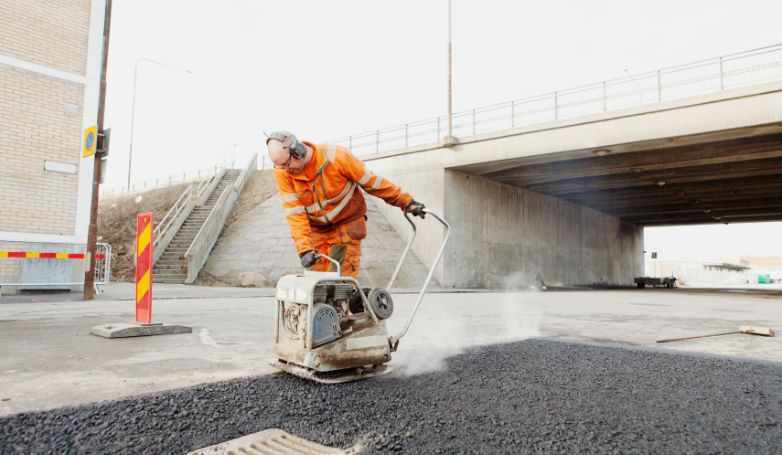
Once the stone bed is prepared, the permeable asphalt mixture is laid over it. The laying process requires precision to ensure that the porosity of the asphalt is maintained. This involves controlling the temperature and compaction techniques during the application. The surface layer is typically thinner than traditional asphalt layers to maximize its effectiveness in water permeation while still bearing the load of traffic.
Quality Control and Testing
Quality control measures are implemented throughout the process to ensure that the porous asphalt meets specific standards. This includes testing the mixture for proper gradation of aggregates, binder content, and porosity levels. Ensuring these parameters are within desired ranges is key to the pavement’s effectiveness in water management and its structural durability.
Finalization and Curing
After laying the porous asphalt, it undergoes a curing process. During this phase, the bituminous binder hardens, and the pavement solidifies. Proper curing is essential for the pavement to achieve its full strength and longevity. The final result is a resilient, permeable surface that efficiently enables water to drain through into the stone bed below and, consequently, into the soil, completing the innovative approach of permeable asphalt pavement construction.
The Durability of Porous Asphalt
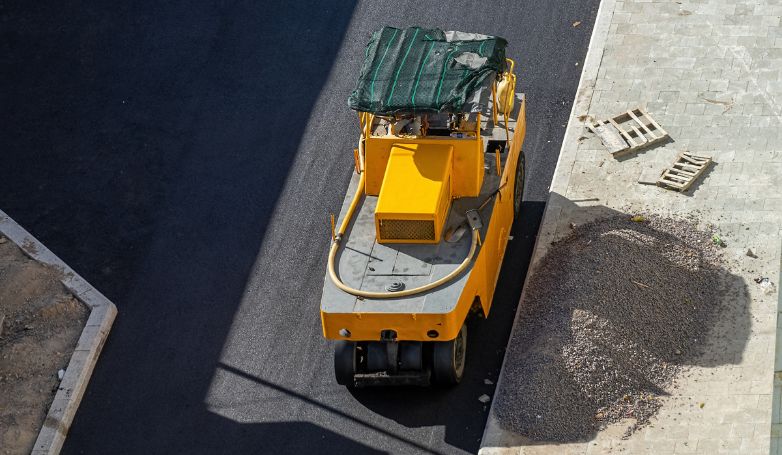
Porous asphalt pavement, when properly designed and installed, can last over 20 years. To maintain its effectiveness, it’s essential to vacuum the surface every quarter. This routine cleaning prevents clogging from sediment and debris. Additionally, the surface can benefit from gentle jet-washing or flushing, which helps preserve its porosity. However, avoid using high-pressure washing as it might damage the pavement.
In winter, it’s important to steer clear of using sand, ash, or salt granules for de-icing, as these can block the pores in the pavement. Instead, de-icing compounds are recommended, as they are effective and do not compromise the porous structure of the asphalt.
How does porous asphalt compare to regular asphalt?
The performance of porous asphalt pavement is similar to that of most other asphalt pavements. Like other pavement, it can be designed for many situations.
The cost of a porous pavement installation is higher than the price of conventional asphalt due to its thicker nature.
Porous Asphalt is a pervious pavement designed to allow stormwater infiltration through the surface into the soil below. The water is naturally absorbed and filtered, and the pollutants are removed. In contrast, regular asphalt pavement is an impervious surface that sheds and repels rainfall and surface pollutants. The water is forced to run off paved surfaces directly into nearby storm drains and then into streams and lakes.
Benefits of Porous Asphalt Use

Porous asphalt is more than just a paving material; it brings a multitude of environmental and practical benefits, particularly in urban and developed areas. Here are some key advantages of using porous asphalt in various applications:
Efficient Land and Water Conservation
Porous asphalt is highly beneficial in land development, as it optimizes land usage and aids in water conservation. Its open structure allows for the replenishment of water tables and waterways, reducing the reliance on storm sewer systems.
Storm-Water Management and Water Quality Improvement
One of the key advantages of porous asphalt is its capacity to manage storm-water effectively. It promotes infiltration and plays a significant role in enhancing water quality by reducing the demand on storm sewer systems.
Pollution Reduction and Environmental Protection
The use of porous asphalt significantly lowers the pollutants carried to storm drains or waterways. This is particularly important in urban development, where impervious surfaces can lead to increased runoff, floods, erosion, and habitat degradation for aquatic life.
Impact on Urban Runoff and Waterway Health
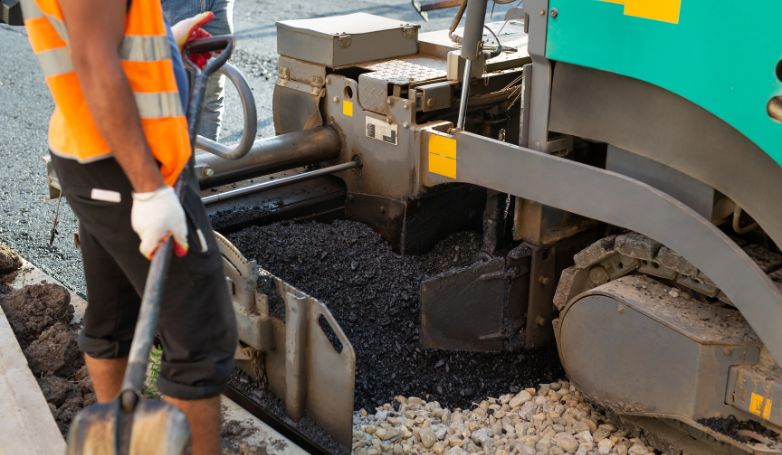
Porous asphalt addresses the issue of water runoff in urban areas. It prevents pollutants like dirt, grease, and oil from being carried into local waterways, thereby protecting the integrity of local drinking water sources and natural habitats.
Groundwater Replenishment and Runoff Management
Designers have developed porous paving systems to allow runoff to percolate through the pavement, replenishing groundwater supplies. Properly installed and maintained permeable paving can infiltrate up to 80% of annual runoff volume.
Pollutant Removal Efficiency
Studies have demonstrated porous asphalt’s effectiveness in removing pollutants. It can eliminate a significant percentage of total suspended solids (TSS), metals, and hydrocarbons, contributing to a cleaner and safer environment.
Cool Pavement Technology and Urban Heat Mitigation
Porous asphalt is recognized as “cool pavement technology.” Its structure helps mitigate the urban heat island effect, reducing pavement energy storage and enabling rapid cooling through evaporation.
Benefits for Roadways: Safety and Comfort
For roadways, porous asphalt offers additional benefits such as reduced noise from tires and engines, increased wet-weather traction, and enhanced visibility during rainy conditions, contributing to safer driving experiences.
Cost benefits of using Porous Asphalt
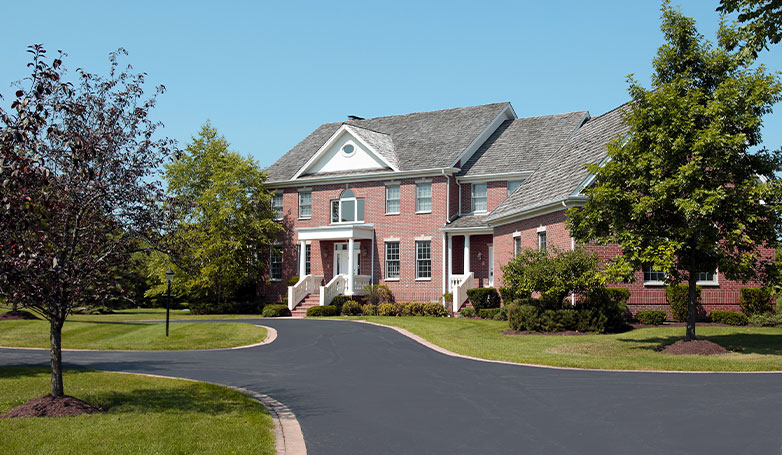
Porous asphalt, while initially more expensive than traditional alternatives, offers significant cost benefits in the long run. Here’s a breakdown of how choosing this option can lead to financial savings despite its higher upfront costs:
Higher Initial Cost but Long-Term Savings
Although porous asphalt roads are thicker and require more materials, making them 20-50% more expensive in unit material costs than traditional asphalt, they offer long-term cost savings. This is due to several factors that reduce additional expenses typically associated with standard paving methods.
Elimination of Stormwater Impact Fees
In many areas, developers incur stormwater impact fees when runoff from their projects overwhelms local storm sewer systems. This asphalt, by reducing the demand on these systems, can lead to the elimination of these fees, offering substantial savings.
Avoidance of Retention Pond Expenses
The design of this asphalt negates the need for traditional stormwater management solutions like retention ponds. This not only saves the cost of constructing these features but also frees up land for more profitable uses, enhancing the overall value of the project.
Faster Construction and Reduced Labor Costs
Compared to other permeable pavements, porous asphalt can be laid down more quickly. It requires less time for pouring and rolling compared to concrete, which needs to be cut and cured. This accelerated construction process leads to shorter road closures and, consequently, lower labor costs, further contributing to its cost-effectiveness.
Examples of Porous Asphalt used for stormwater management
People have successfully used porous asphalt pavements for over 35 years in a variety of climates around the United States.
In 1977, Walden Pond State Reservation in Massachusetts used the material for their visitor’s center parking lot. Since installation, the local water table has been raised, and erosion, pollution, and the need for storm drains or road salt has been reduced. Walden Pond State Reservation continues to use porous asphalt pavement to protect a site that serves as one of our most treasured literary muses “Walden Pond”.
Built in 2007, Pringle Creek in Salem, Oregon, was conceived as a 32-acre eco-friendly community. Its building designs, landscaping, energy systems, and stormwater control scheme depend on roads and parking lots constructed with porous asphalt pavement. This type of asphalt effectively filters and stores stormwater.This process allows it to percolate back into the ground rather than add to the drainage system load that flows into creeks and rivers.
The system worked well initially, but no one knew how it would perform in severe weather conditions. When a severe storm flooded roads and rivers all over the Salem area in January of 2012, Pringle Creek community experienced nothing more than a puddle or two.
The community’s green stormwater system had protected the environment and saved residents from potentially millions of dollars of storm damage.
Installation of porous asphalt
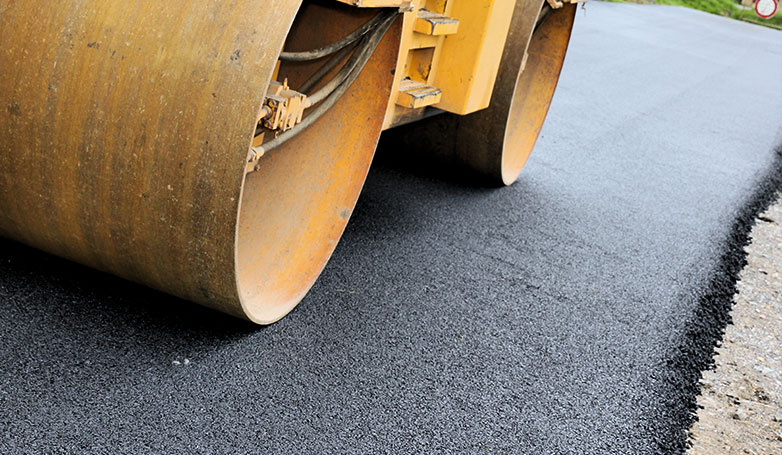
The installation of porous asphalt is a straightforward process that doesn’t require specialized equipment or proprietary ingredients, making it accessible for general paving contractors. Here’s a closer look at the installation process:
Accessibility of Installation
Porous asphalt pavement is user-friendly in terms of installation. It doesn’t demand special ingredients or equipment, which means most general paving contractors already possess the necessary tools and expertise to install it. This makes the asphalt a viable option for a wide range of projects.
Flexible Application
Contractors can install porous asphalt pavements fully or partially, alongside traditional impervious asphalt pavements.. This versatility allows for a tailored approach to pavement design, catering to specific environmental and infrastructural needs.
Layered Design for Optimal Performance
The design of porous asphalt involves at least four distinct layers, each serving a specific purpose in the pavement’s overall functionality:
- Asphalt Layer (2 to 4 inches): This top layer is made of bituminous asphalt, with reduced fines to create void spaces, making it permeable. The void space in porous asphalt is approximately 16%, significantly higher than the 2 to 3 percent in traditional asphalt mixes. This design allows for some pretreatment of runoff.
- Filter Layer (1 to 2 inches): A half-inch crushed aggregate acts as a filter layer, aiding in pollutant removal and providing stability to the underlying stone reservoir during pavement application.
- Reservoir Layer (Minimum 12 inches): This layer consists of 1 to 3-inch aggregate and serves as a storage area for treated water runoff. It’s a highly permeable bed of clean-washed aggregate with at least 40% void space.
- Geotextile Material: A layer of nonwoven geotextile material placed between the reservoir bed and the un-compacted subsoil prevents the migration of fines into the stone reservoir, which could lead to clogging.
Each of these layers plays a crucial role in ensuring the efficient performance and longevity of the porous asphalt pavement.
Maintenance requirements of Porous Asphalt
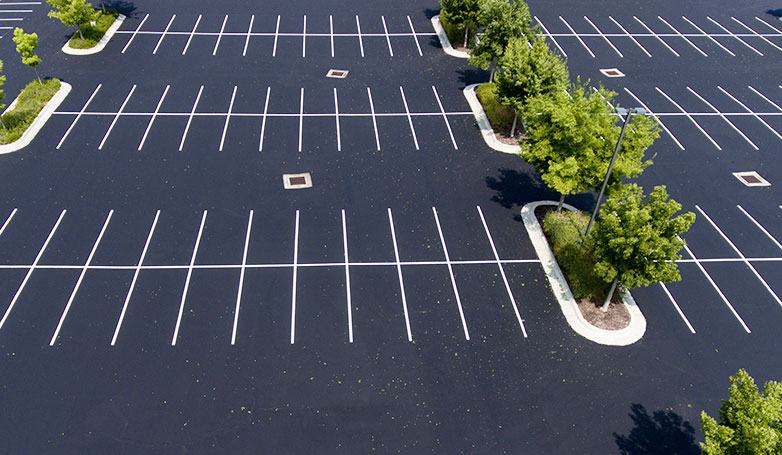
Maintaining porous asphalt is essential to preserve its stormwater management capabilities and overall longevity. Here’s a guide to the maintenance requirements for the asphalt pavements:
Maintenance for Hydrological Benefits
The use of this type of asphalt primarily aims to enhance the hydrological properties of roadways and site designs. With evolving stormwater ordinances, there’s an increasing emphasis on onsite stormwater infiltration and detention.
Annual Infiltration Rate Inspection
To ensure the long-term effectiveness of porous asphalt in managing stormwater, it’s crucial to inspect the surface infiltration rates annually. This involves observing the pavement during rain events to detect any changes in its ability to effectively infiltrate stormwater.
Regular Cleaning Schedule
Porous asphalt pavements require cleaning two to four times a year. This can be done through vacuuming or power-washing to remove solids and debris that might cause clogging. Regular cleaning is essential to prevent permanent clogging and maintain the pavement’s permeability.
Winter Maintenance
During winter, porous asphalt does not require any special plowing methods. Workers can use deicing chemicals to melt ice and snow, but they typically use lesser amounts compared to impervious pavements. This reduced need for deicing chemicals is another important benefit.
Avoiding Seal Coating and Managing Repairs
It is important to avoid seal coating or crack sealing on the asphalt, as these processes can impair its permeability. For patching, a conventional mix may be used but only if the affected area is less than 10% of the pavement. This ensures that the majority of the pavement maintains its porous characteristics.
Porous Asphalt will not work for every stormwater project
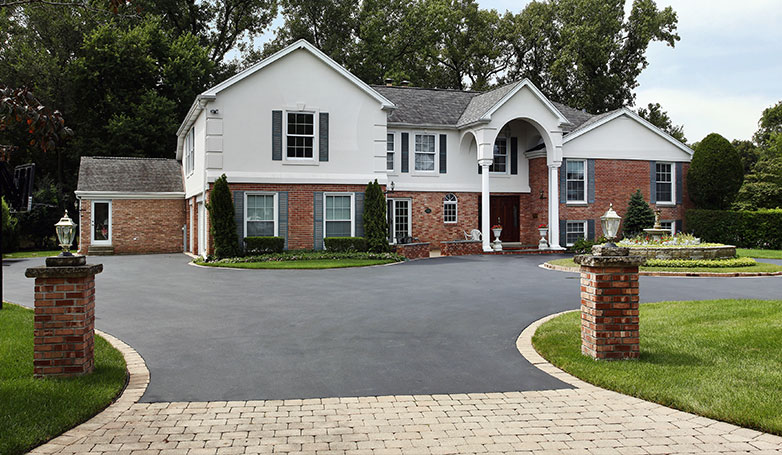
While porous asphalt offers numerous benefits for stormwater management, it’s not suitable for every project due to various environmental and usage factors. Understanding these limitations is key to determining the appropriateness of this material for specific projects:
Physical Factors in Design
Soil characteristics, local topography, and climate are crucial in designing porous asphalt pavements. Designers often recommend porous asphalt for sites with gentle slopes, permeable soils, and a sufficiently deep water table and bedrock level.
Traffic Considerations
The durability of porous asphalt under different traffic conditions is a point of concern. It’s primarily used in areas with slower traffic, like parking lots, road shoulders, pedestrian and bike paths, driveways, and residential streets. High traffic areas or routes used by heavier vehicles may lead to cracking and reduced pavement lifespan.
Environmental Constraints: Dust and Wind
Dust is a significant environmental factor affecting porous asphalt. In areas prone to moderate to high winds and barren landscapes, blowing dust can clog the pores of the pavement, hindering water percolation. In such environments, this asphalt may not be the best choice.
Growing Popularity in Sustainable Engineering
Despite these limitations, porous asphalt is a rapidly growing technology in sustainable roadway engineering. It offers hydrological benefits, aligning with recent developments in stormwater ordinances that emphasize onsite stormwater infiltration and detention.
Pollution Reduction Capabilities
Porous pavement, including this type of asphalt, can mitigate the adverse effects of impervious surfaces. It reduces pollutant concentrations by trapping them physically, chemically, or biologically, contributing to a cleaner environment.
Cost-Effective and Eco-Friendly Solutions
With proper design and installation, porous asphalt can be a cost-effective solution for managing stormwater in an environmentally friendly manner. It is recognized as a best eco-practice by the U.S. Environmental Protection Agency and various state agencies, underscoring its value in sustainable infrastructure development.
Conclusion
In conclusion, porous asphalt stands out as a highly effective and sustainable paving solution, particularly in the context of modern stormwater management challenges. While it presents certain limitations regarding site conditions, traffic capacity, and environmental factors such as dust and wind, the benefits it offers in terms of hydrological management, pollution reduction, and eco-friendliness are substantial. Its growing recognition by environmental agencies and incorporation into sustainable engineering practices highlight its potential in shaping future infrastructural developments.

